Curbside Capture of Desert Rain
Air Date: Week of June 2, 2023
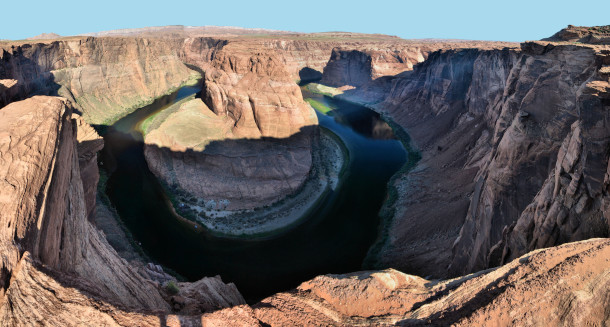
The city of Tucson, Arizona, imports the majority of its water from the drought-stricken Colorado River, via the 336 mile long Central Arizona Project Canal. (Photo: John Morton, Flickr, CC BY 2.0)
Thirty years ago, a neighborhood group in Tucson started harvesting local rainwater by directing runoff into street-side basins filled with native, food-bearing plants. Co-founder Brad Lancaster joined Living on Earth’s Bobby Bascomb to tell how “planting the rain” improves neighborhoods, builds climate resilience, and helps the desert bloom.
Transcript
CURWOOD: Climate disruption is the main culprit for the blistering megadrought that has plagued the southwest US for decades, though this year winter snows helped encourage water negotiators in Arizona, California, and Nevada. Those states were able to agree to reduce their use of the Colorado River by three million acre-feet of water over the next three years, with the help of some federal money, but at best it’s a temporary solution. One of the biggest customers of Colorado River water is Tucson, Arizona, which taps the 336-mile-long Central Arizona Project Canal. Rainfall dumps roughly a million gallons per mile per year on Tucson’s residential streets, and most simply goes down storm drains. But a precious portion of this renewable resource stays behind. Thirty years ago, the Dunbar Spring Neighborhood Foresters Organization started harvesting local rainwater by directing runoff into side-street basins filled with native, food-bearing plants. Brad Lancaster, co-founder of the organization, joined Living on Earth’s Bobby Bascomb to tell how “planting the rain” improves neighborhoods, builds climate resilience, and helps the desert bloom.
BASCOMB: So, paint a picture of Dunbar Spring for us. What does it look like today?
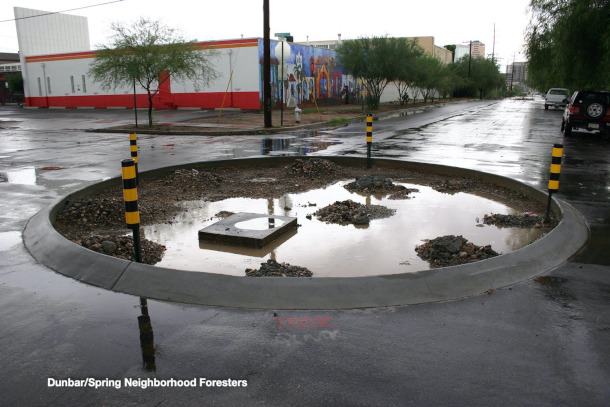
About a million gallons per mile per year of rain falls on typical Tucson residential streets, but the majority of that local water disappears down storm drains. (Photo: Brad Lancaster)
LANCASTER: Well, today, the majority of our streets are lined with native food-bearing trees and understory plants. So, you get to walk through these wonderful tunnels of edible shade. And we've got over two dozen native bird species that have returned to our neighborhood since we've regrown their habitat, that sing to you as you walk along. We have bicycle boulevards going through our neighborhood, which used to be speeding streets, and lots more families than there used to be. And even goats.
BASCOMB: Goats! Tell me more about the goats.
LANCASTER: So we've got some goats, we take them on walks once a day.
BASCOMB: Oh, my god. That sounds adorable.
LANCASTER: Well, and they're great, too, in that they help us prune the pathways from knee-level down. And they're kind of unofficial mascots of some of our efforts.
BASCOMB: Oh, my gosh, I love it so much. And I understand that this is not what it looked like, you know, just 30 years ago. What did you start with? And how did you even get started on a project like this?
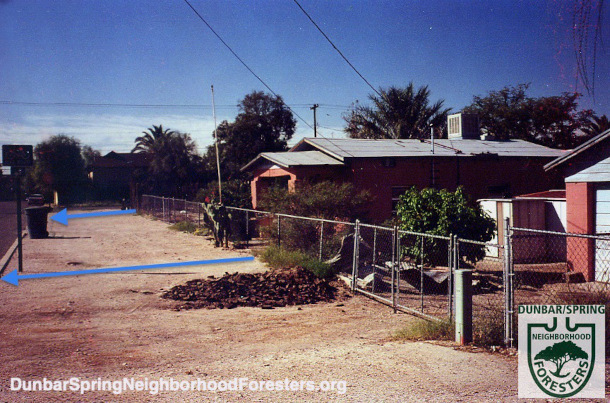
Thirty years ago, the Tucson neighborhood of Dunbar/Spring had little to no street trees, making exposed streetscapes unbearable in the summer months. The blue arrows indicate lost water flow to the street. (Photo: Brad Lancaster)
LANCASTER: Yeah, so my brother and I moved to the neighborhood in 1994. Wonderful neighborhood, extremely diverse, but the public rights of ways, the streetscapes, were for the most part solar oven-like experiences. There was very few street trees, and we're the third fastest-rising temperatures of any city in the US. So, you didn't really want to be out and about where you might interact with a neighbor in the hot months. And what got us wanting to shift all that is when we moved to the neighborhood, the neighbors were being facilitated by a local architect to see, what did the neighborhood want? So, people wanted more tree planting. There had apparently been some tree planting projects in the past, but many of those trees didn't make it. So, I was young and full energy, so I decided to step up and spearhead that effort.
BASCOMB: And you just mentioned that a lot of trees were planted, but they didn't survive. What did you do differently?
LANCASTER: Well, first off, we did some research on what trees were planted in the past, and found that they were all exotic trees. None of them were native to the area. And they were susceptible to drought, cold, insect damage, especially if they weren't watered regularly. So we then looked to our native environment. We have over 400 native food-bearing plants, many of which are trees, in the Sonoran Desert. And then we went further. Instead of just using the hardy native trees, we also researched, which were the trees that produced multiple benefits for many lives, people and otherwise. So, we looked at what were traditionally used as food trees, medicinals, craft materials like fiber, dyes, and so forth. And then we prioritized those trees amongst our native trees to set our tree list.
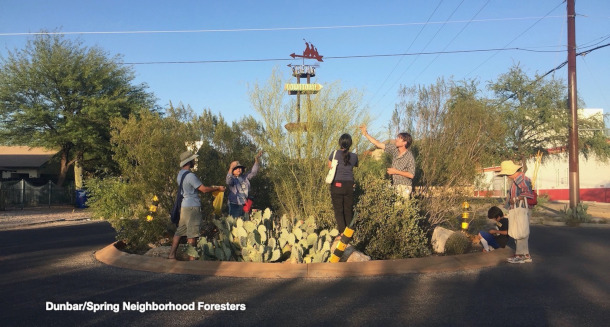
Over the last few decades, the Dunbar/Spring Neighborhood Foresters Organization has planted native, food bearing trees and understory plants in streetside basins that take advantage of local rainwater harvesting. (Photo: Brad Lancaster)
BASCOMB: So, both native trees that were going to survive better and offer some sort of useful product to the people living in the neighborhood.
LANCASTER: Yeah, because we wanted to have more potential deeper relationships. And we didn't want people just to look upon it as shade or beauty. We wanted them to see well, you know, it's a living pantry. It's a living pharmacy. It's a living hardware store and craft shop. And it's this amazing habitat for all this wildlife that had disappeared from our neighborhood when we removed their habitat.
BASCOMB: Well, can you give us a few examples of the specific plants that you planted there and how they're used by people?
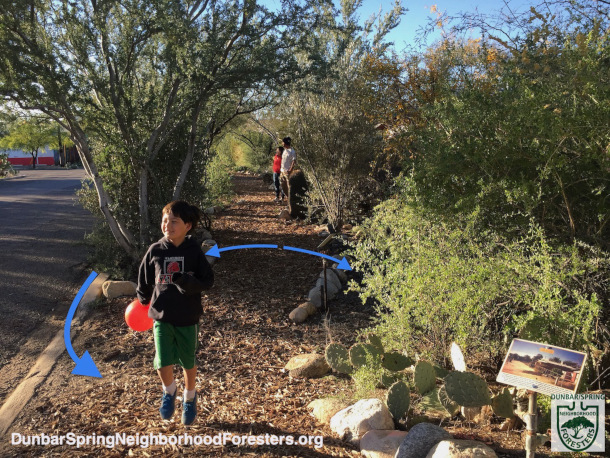
The neighborhood is now lined with shaded pedestrian pathways. (Photo: Brad Lancaster)
LANCASTER: So one of the trees is the native velvet mesquite tree. It has edible seed pods and wonderful edible sap as well that's a great throat lozenge and desert candy. And it fixes nitrogen in the soil. Then there's the desert ironwood tree, which has green seeds when immature, that you can process and eat like edamame. And then when they mature, you can process and eat them like peanuts. Then there's the paloverdes. And they have edible yellow flowers and kind of like green bean-flavored seeds when immature. And then once they mature, we can grind them up into a cornmeal-like flavor.
BASCOMB: Amazing. I mean, I have to say, I wouldn't know the first thing to do with any of these plants. To what degree did you have to do some community outreach to allow people to use them so they knew what they were working with?
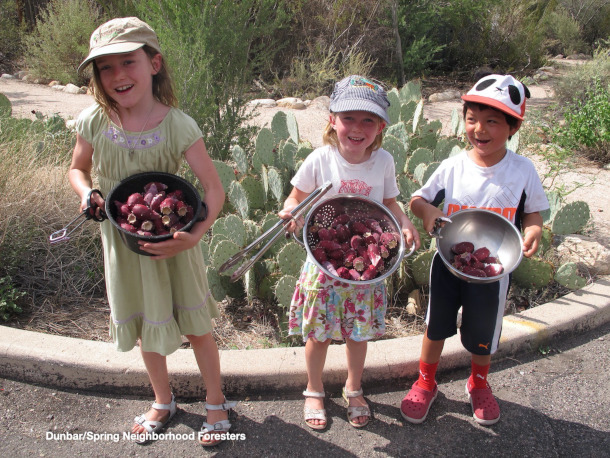
Local residents of all ages are able to harvest edible plants like the prickly pear fruit. (Photo: Brad Lancaster)
LANCASTER: Well, we had to do a fair amount, not just for our neighbors, but for ourselves as well. Because we read about all of this, but we didn't have direct experience with all these foods when we started. So, we sought out folks that had this knowledge, and we also looked to books and just experimented. And the other cool thing is we've collaborated with the University of Arizona Arboretum to put plant identification signs for many of the plants, not just the trees, but the understory plants too, in four languages. So it's the scientific name in Latin, the English common name, the Spanish common name, and the O'odham common name.
BASCOMB: And the O'odham name is the Native American tribe of the region.
LANCASTER: Exactly, yes. And when people hit the QR code on the plant ID sign, it takes them to a page where they can see the plant in bloom, in fruit. It's got ways of preparing it, and tells other plants that it likes to grow with. So people can be educated in many layers on how to grow more of the forest on their block.
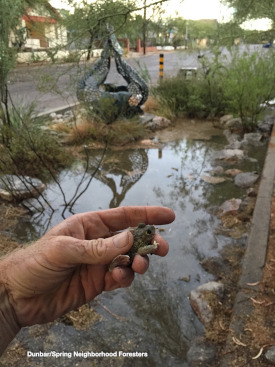
Native plants are also helping restore wildlife habitats in the area. (Photo: Brad Lancaster)
BASCOMB: And to what degree have you seen that? Are people taking this, you know, common space and applying it to their own, you know, private yards?
LANCASTER: Definitely. The neighborhood is much greener than before we started all this. And another key thing is, we really push folks to plant the rain before they plant any plants. And that's another thing that sets our planting project apart from most, because a typical tree planting project is bringing in water from the municipal system. So water imported from elsewhere, because in Tucson, the bulk of our water comes from the Colorado River, and we pump it from over 300 miles away. So we wanted to use the free local water because we found that you know, the average one-mile stretch of our neighborhood drains enough rainfall to support over 400 trees per mile, or one tree every 25 feet on both sides of the street -- if we direct the street runoff to streetside basins, as opposed to out of the system.
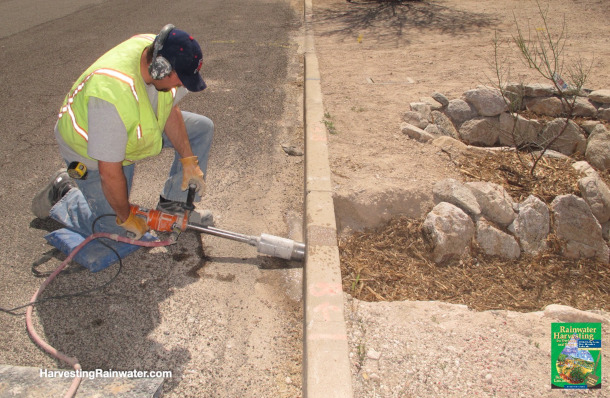
The Neighborhood Foresters now collaborate with contractors to drill holes in street curbs, allowing rainwater to be directed into plantable basins rather than into storm drains. (Photo: Brad Lancaster)
BASCOMB: Well, tell me more about how you're directing water exactly where you want it to go, and how it's, you know, maybe staying on the land a little bit better, and that might be useful in you know, a very dry area like Arizona.
LANCASTER: Our streets for the most part are raised or crowned in the middle, so they drain water to either side. So water will flow along that curb. And we noticed that it would kind of lap up where there'd be a dip in the curb. So we started to cut the curb or notch the curb where there was all this plantable unpaved dirt on the household side, but no access for the water. So we would cut the curb at that point, dig the basin down, and then when it would rain, water would flow down the gutter, go into that curb cut, and once the basin would be filled, water would backup to the inlet point. And then the surplus would go down the gutter to the next basin. And now our average basin size is eight feet long, five feet wide and one foot deep, for an annual minimum capacity of 4,500 gallons per year. And that's enough water to sustain all the water needs of the tree we plant beside or within that basin and all the understory plants as well, with surplus water to then directly recharge the aquifer.
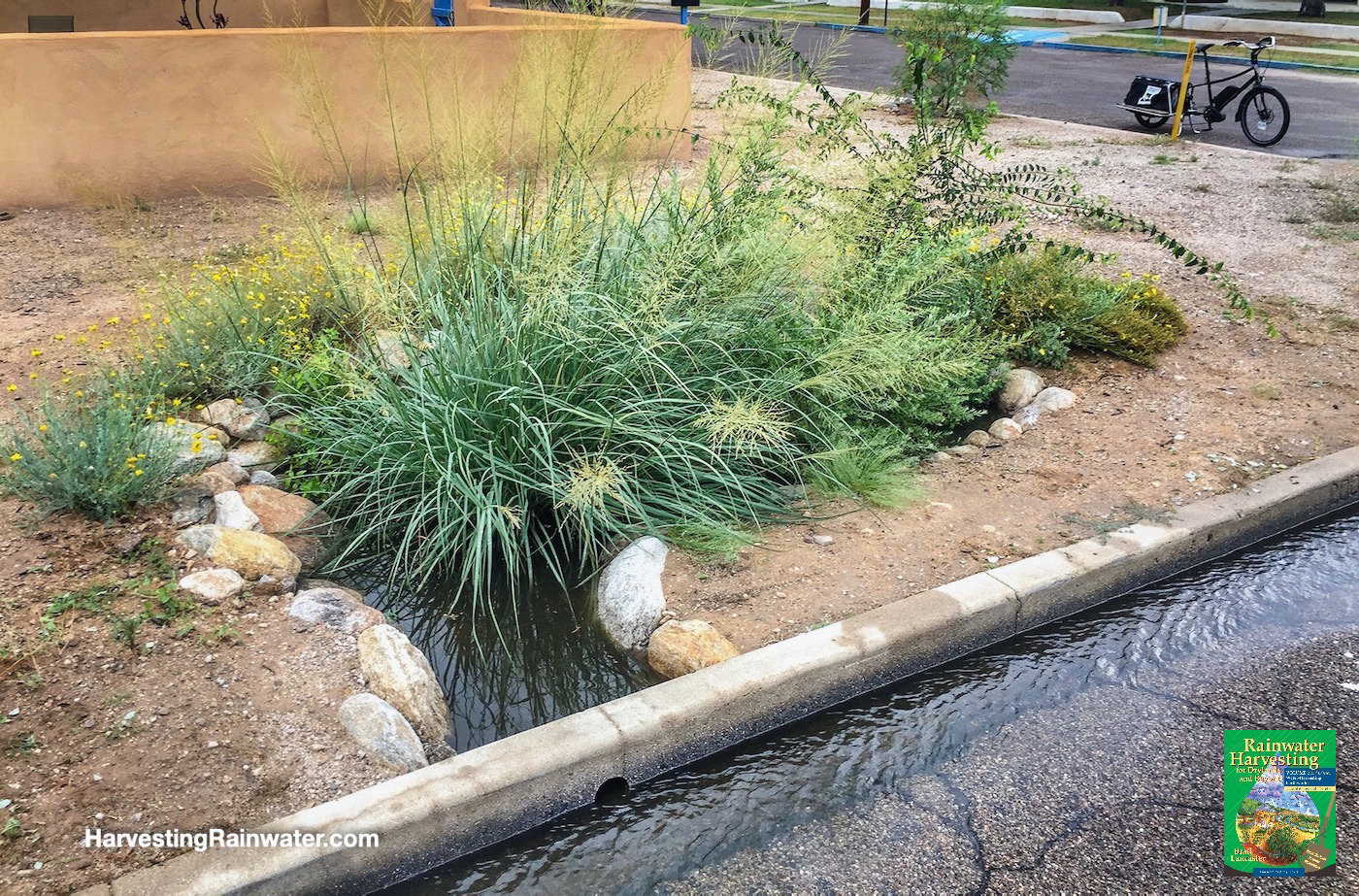
The average Dunbar Spring streetside basin has an annual minimum capacity of 4500 gallons of stormwater per year. (Photo: Brad Lancaster)
BASCOMB: And this isn't you know, some great technology that needs to be invented that we're talking about. These are really very simple techniques that you've, you know, implemented.
LANCASTER: Yes. And indigenous techniques to this place. The O'odham, the indigenous people of this place, they would harvest water flowing down an ephemeral arroyo, or creek, during a storm. And they would direct it into the adjoining flood plain, where they'd grow their crops. We're doing the same thing. But in this urban setting, the paved street is the arroyo, or the waterway. So we lost the bulk of this knowledge when there was active efforts to eradicate it from the indigenous knowledge in the Indian schools and so forth. They would punish you for practicing some of this stuff. So we're trying to bring it back. And it's a slow rebuild, but it's definitely happening.
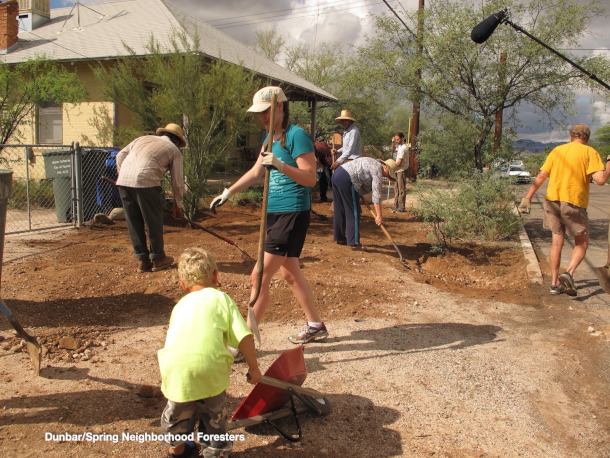
Urban rainwater harvesting has roots in indigenous O’odham knowledge. (Photo: Brad Lancaster)
BASCOMB: Well, we know that the region is expected to get hotter and drier in the coming years with climate change. And already the Colorado River that much of the West depends on is at record lows. How do you think this type of urban planning should be worked into western communities going forward? And for that matter, how scalable is it? I mean, you're talking about a relatively small neighborhood. Can something like this be done, you know, on a city level, like Las Vegas or Los Angeles even?
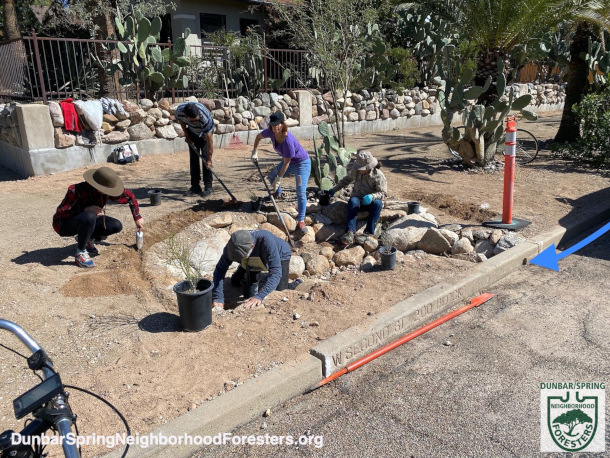
The Neighborhood Foresters hope to spread rainwater harvesting techniques to other areas in the west and beyond. (Photo: Brad Lancaster)
LANCASTER: Absolutely. And I've done workshops in both Las Vegas and LA, and the installations we've done have been working fantastic. So, when we started this, it was illegal in Tucson to cut the street curbs. So we just did a guerilla action on a Sunday morning when no one from the city was watching. And then slowly grew it. And then when we had a viable system going, then we approached the city to legalize it. They've since legalized it. They've mandated it in all new city road construction and major road renovation, and they incentivize it with a $2,000 rebate. So this can happen anywhere, doing this in a similar way. And we find there's the greatest cluster of density of water harvesting anywhere there's someone that was already doing it, because most folks don't walk more than a block in their neighborhood unless they got a dog or a goat. So, if they only have to walk a half a block or so to get more information or to see an example, it takes off there.
BASCOMB: I mean, to what degree is this something that could really address the problem of, you know, drought in the West?
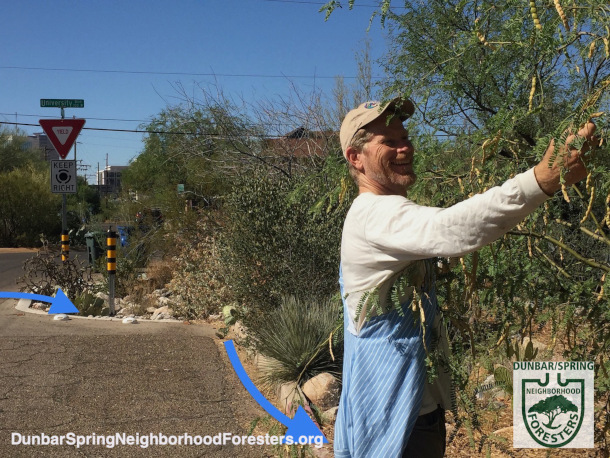
Co-founder of Dunbar Spring Neighborhood Foresters Brad Lancaster says harvesting local rainwater could build drought resilience in larger cities like Los Angeles or Las Vegas. (Photo: Jaime Chandler)
LANCASTER: Well, we should be using rainwater as our checking account water, you know, the water you use on a daily basis. And our groundwater, or Colorado River water, that should be the savings account that you don't touch, except for extreme times of need, like an extreme drought year. But instead, what we're doing today throughout the West, is we're discarding the free onsite waters. And then we're just tapping and draining the savings account for ourselves, our children, and their children.
CURWOOD: Brad Lancaster, a cofounder of the Dunbar Spring Neighborhood Foresters in Tucson, speaking with Living on Earth’s Bobby Bascomb.
Links
About Dunbar/Spring Neighborhood Foresters
Harvesting Rainwater | “Rainwater Harvesting for Drylands and Beyond by Brad Lancaster”
Living on Earth wants to hear from you!
Living on Earth
62 Calef Highway, Suite 212
Lee, NH 03861
Telephone: 617-287-4121
E-mail: comments@loe.org
Newsletter [Click here]
Donate to Living on Earth!
Living on Earth is an independent media program and relies entirely on contributions from listeners and institutions supporting public service. Please donate now to preserve an independent environmental voice.
NewsletterLiving on Earth offers a weekly delivery of the show's rundown to your mailbox. Sign up for our newsletter today!
 Sailors For The Sea: Be the change you want to sea.
Sailors For The Sea: Be the change you want to sea.
 The Grantham Foundation for the Protection of the Environment: Committed to protecting and improving the health of the global environment.
The Grantham Foundation for the Protection of the Environment: Committed to protecting and improving the health of the global environment.
 Contribute to Living on Earth and receive, as our gift to you, an archival print of one of Mark Seth Lender's extraordinary wildlife photographs. Follow the link to see Mark's current collection of photographs.
Contribute to Living on Earth and receive, as our gift to you, an archival print of one of Mark Seth Lender's extraordinary wildlife photographs. Follow the link to see Mark's current collection of photographs.
 Buy a signed copy of Mark Seth Lender's book Smeagull the Seagull & support Living on Earth
Buy a signed copy of Mark Seth Lender's book Smeagull the Seagull & support Living on Earth

